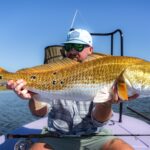
Louisiana Bull Reds Up for Harvest Again: H.B. 604 Must Not Pass
Photo Credit: Carter Abramson | Trevor Johnson Every now and then, we encounter something so
By Tony Friedrich, VP/Policy Director
On Tuesday, August 3rd, the Striped Bass Management Board met to discuss 2020 fishery performance and progress on Amendment 7. We were content with the way the Amendment 7 was going, as many of the most concerning issues initially included in the Amendment 7 Public Information Document (PID) were removed at the May meeting. We had release mortality, management triggers, conservation equivalency, and protecting the 2015 year class left on the table, the first three of which were discussed on August 3. We have another blog ready to go on Amendment 7 progress. However, a new problem emerged at the end of the meeting that needs a spotlight. So, here we go!
One of the last topics discussed on August 3 was commercial allocation (see p. 53). During the PID process, ASGA did not oppose the commercial quota allocation portion of the PID for Amendment 7; after all the harvest data used for striped bass commercial allocation is the oldest used for any species managed by the ASMFC. However, the stopgap measure approved for consideration two weeks ago as a rushed, roundabout way to address allocation concerns is a threat to overfished striped bass that impedes the public’s ability to meaningfully weigh in.
So why the need to address commercial allocation? It’s being driven by Delaware, whose commissioners have asserted for years that the state’s quota is inequitably low because it’s based on outdated information. Over the last several months, Delaware’s commissioners worked with ASMFC staff to explore solutions to the allocation problem.
Topics at the end of meetings are always a concern. Board members are tired, schedules are tight, and sometimes issues don’t get fleshed out properly. After a brief discussion of the commercial problem, the following motion passed by one vote:
Connecticut, Delaware, Virginia, New York, Rhode Island, Maryland, North Carolina, and Potomac River Fisheries Commission voted to approve. Maine, New Jersey, Pennsylvania, Massachusetts, New Hampshire, NOAA Fisheries, and the U.S. Fish and Wildlife Service all voted against.

Please note that the motion states, “Move to initiate an addendum to amendment 6.” Wait, we are working on Amendment 7, aren’t we? Amendment 7 is moving through very quickly already with plans to be completed by February 2022, and commissioners voted to remove the commercial allocation issue due to fears that it would bog down the process. But rather than wait until the current management issues are settled—only a few months away—commercial allocation is now being added as a parallel separate action modifying the current amendment (Amendment 6) for implementation in 2022.
So, why are we concerned about this? Take a look at the chart below:

There are over 2 million pounds of transferable quota up for grabs. When we discussed this issue on a call with Delaware commissioners earlier in the Amendment 7 process, they explained how their small commercial fleet could really benefit from a bump in quota. Okay, 50,000 pounds would be a 36% increase over the 2020 harvest, and is about 1% of the total coastwide commercial striped bass quota. North Carolina hasn’t used a single pound of their 295,000 pounds quota for years. There seems to be a simple solution here—maybe allowing transfers only to Delaware with a 50,000 pound cap—but opening 2 million pounds for “voluntary transfers” seems akin to mosquito hunting with an elephant gun.
The striped bass stock is at a twenty-five-year low. ASMFC Executive Director Bob Beal acknowledged that the current ban on transfers is a holdover from when the Board was rebuilding striped bass back in the late ‘80s and early ‘90s, and yet here we are with an overfished stock, considering allowing transfers. Does this really make sense? If the commercial sector is 2 million pounds below hitting their quota, isn’t that a pretty good indicator that the stock isn’t doing very well? Can you imagine what would happen if we had a good year class in Maryland and the state gets a big transfer the same year these fish become legal harvest size? Look no further than the fourth best on record 2011 year-class. It was slaughtered in Maryland waters and never recruited to the ocean in appreciable numbers. Yes, we recognize that commercial fishing only accounts for about 10% of striped bass mortality and has better data than we do on the recreational side. Even so, a dead fish is a dead fish, and tinkering with transfers to enable killing more fish when the stock is 25% below the overfished threshold just is not the right move.
It doesn’t take a polished policy professional to foresee the horse trading that could erupt from allowing commercial striped bass quota transfers. Let’s say a state or jurisdiction wants a vote on a certain issue or a quota for another species and they just happen to have a few hundred thousand pounds of unused striped bass quota. What do y’all think will happen? A few phone calls, emails, and maybe a Zoom meeting later and the public will be essentially removed from the backdoor deals that will ensue.
Yes, these quota transfers must be approved by the board but is that really a safety net? There are quota transfers for a lot of species. Many states take advantage of existing quota transfers. This reliance will cause commissioners to vote for their own interests rather than the fate and health of striped bass.
Where We Go From Here:
Public comment on this proposal will take place from Nov-Dec 2021. Because it is part of Amendment 6, the Board will be soliciting comments on transfers at the same time that it’s asking for feedback on draft Amendment 7 (which will likely be approved at the October meeting). Confused yet? Don’t worry. That is why we are here. This commercial transfer proposal must be opposed and defeated.
There will only be three public hearings and not one for each state like during the PID process. Furthermore, public comment will be available but taken in survey form (with an option for providing open comments). We aren’t sure how this process will work, but have significant concerns about how inclusive this fast-tracked process will be when it comes to making sure the public’s views are heard. All we can say is that we hope this survey is available in advance of the three public hearings because the survey results can certainly be impacted by the way the questions are written.
Next up: An update on the Amendment 7 process and the next opportunity for action.

Photo Credit: Carter Abramson | Trevor Johnson Every now and then, we encounter something so

This past weekend, ASGA proudly sponsored the Dirty Carp Tournament in Louisiana — and no, you didn’t misread that.

After years of data pouring in from The Albie Project, advocacy, persistence, and support from

This morning, the Connecticut Environment Committee held a hearing on House Bill 6248, a bill
We rely on our members and donations to keep fighting for a sustainable tomorrow in marine conservation.
GIVE THE GIFT OF FISHERIES CONSERVATION THIS HOLIDAY SEASON. SHOP ASGA GOODS THAT FUND FISHERIES RESEARCH & ADVOCACY CAMPAIGNS
JOIN ASGA IN CALLING FOR CRITICAL MANAGEMENT ACTION AFTER YEARS OF SPAWN FAILURES & POOR MANAGEMENT.
By using this website, you agree to our use of cookies. We use cookies to provide you with a great experience and to help our website run effectively. To learn more, please review our privacy policy.
3 Responses
Tony et all at ASGA.
Thank you for keeping us all posted on issues like this and helping us understand the impacts of these management decisions. The issues are complex and mysterious for most of us and your clear analysis is invaluable. Let us know what we can can do to act when necessary and we will spread the word to recruit the involvement of others.
Sincerely,
Capt. Parker Mauck
Westport Fly
Sorry, typo on Capt. (not Caot.)
Thanks for great posting!!